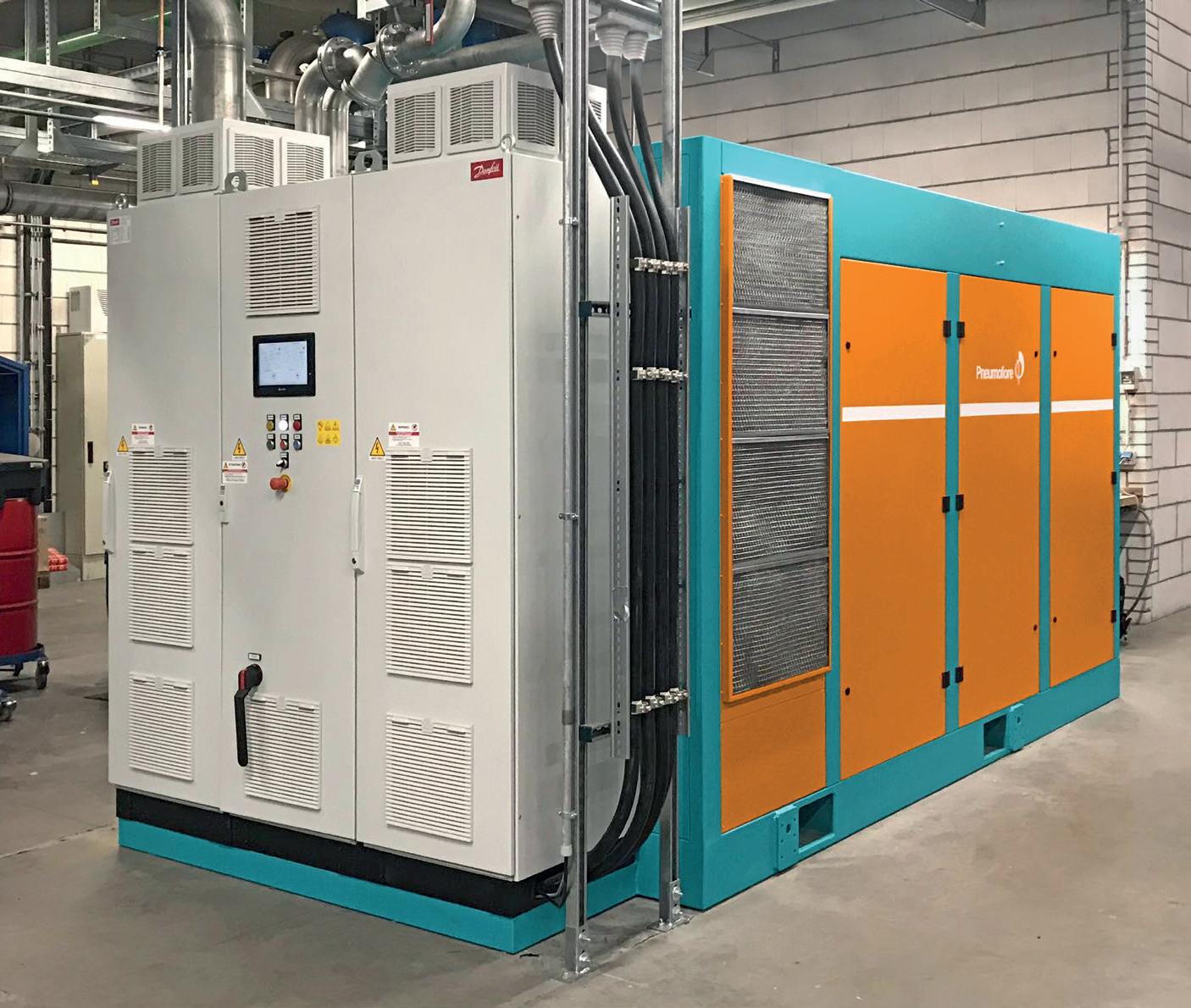
9 minute read
Vacuum technology: Pneumofore
Modernising Vacuum and Pressure in Hollow Glass Production
Daniel Hilfiker* discusses the evolution of vacuum technology and how the use of digital and industry 4.0 elements ensure they continue to remain an integral part of a glass manufacturing facility.
In glassworks, uncertainty prevails for most people when it comes to the use of vacuum, this intangible and elusive state of energy.
Not so for Pneumofore, which has been active for three generations in the global glass community. The familyowned company has nearly a century of experience in supplying dedicated pneumatic solutions for vacuum and compressed air. The secret to its success? Flexibility. Built on the reliable and beneficial simplicity of the rotary vane principle, Pneumofore machines are easily adapted to evolving moulding technologies and the latest supervisory control systems. This article presents real cases of Industry 4.0 networking, connectivity, and security of Pneumofore installations, along with durability and efficiency highlights.
The Right Foundation for Performance
Not that long ago, the approach to vacuum technology was so casual that screw compressors were often used as vacuum pumps by simply reversing inlet and outlet. The evacuating and the compressing version of the same machine differed only little. As vacuum leaks aren’t easily detected, such momentary inefficiency was initially tolerated. But when glasswork furnaces with an average lifespan of 12 years now set the timeframe for efficiency, auxiliary pneumatic equipment needs to perform reliably and economically over that duration. To that end, only volumetric machines with active sealing, such as piston or rotary vane technology, have prevailed as long-term solutions for the heavy duty, continuous operation in glass manufacturing plants.
Criteria for Choosing the Right Equipment
in energy-intense equipment like compressors and vacuum pumps, forwardthinking customers look beyond the purchase price: they also demand exact figures regarding power consumption, spare parts, and maintenance needs. Their analysis can easily look 10 years ahead, especially if they are subject to penalties for falling short of efficiency limits. Pneumofore solutions comfortably satisfy these parameters, as these pumps and compressors are built on rotary vane technology and engineered for long-term, continuous operation at high efficiency. Extended warranties can further guarantee performance, though in the case of compressors and vacuum pumps, the manufacturers are limited by the warranties of their own suppliers of critical components, such as electric and electronic devices. That said, the key mechanical machine components manufactured in-house, like the pumping Air-End, are often covered by extended manufacturer warranties - up to seven years for Pneumofore Air-Ends. In addition to technical specifications and contractual conditions, customers should ask for references and collect feedback from the end user, preferably about older installations. Pneumofore still receives testimonials for the V100 pumps running since 1991 at the Verallia plant in Villa Poma, Italy, among many others. Within this modernised factory, which was the object of important investments when its furnaces were recently rebuilt, all the IS machines were upgraded, whereas the
Continued>>
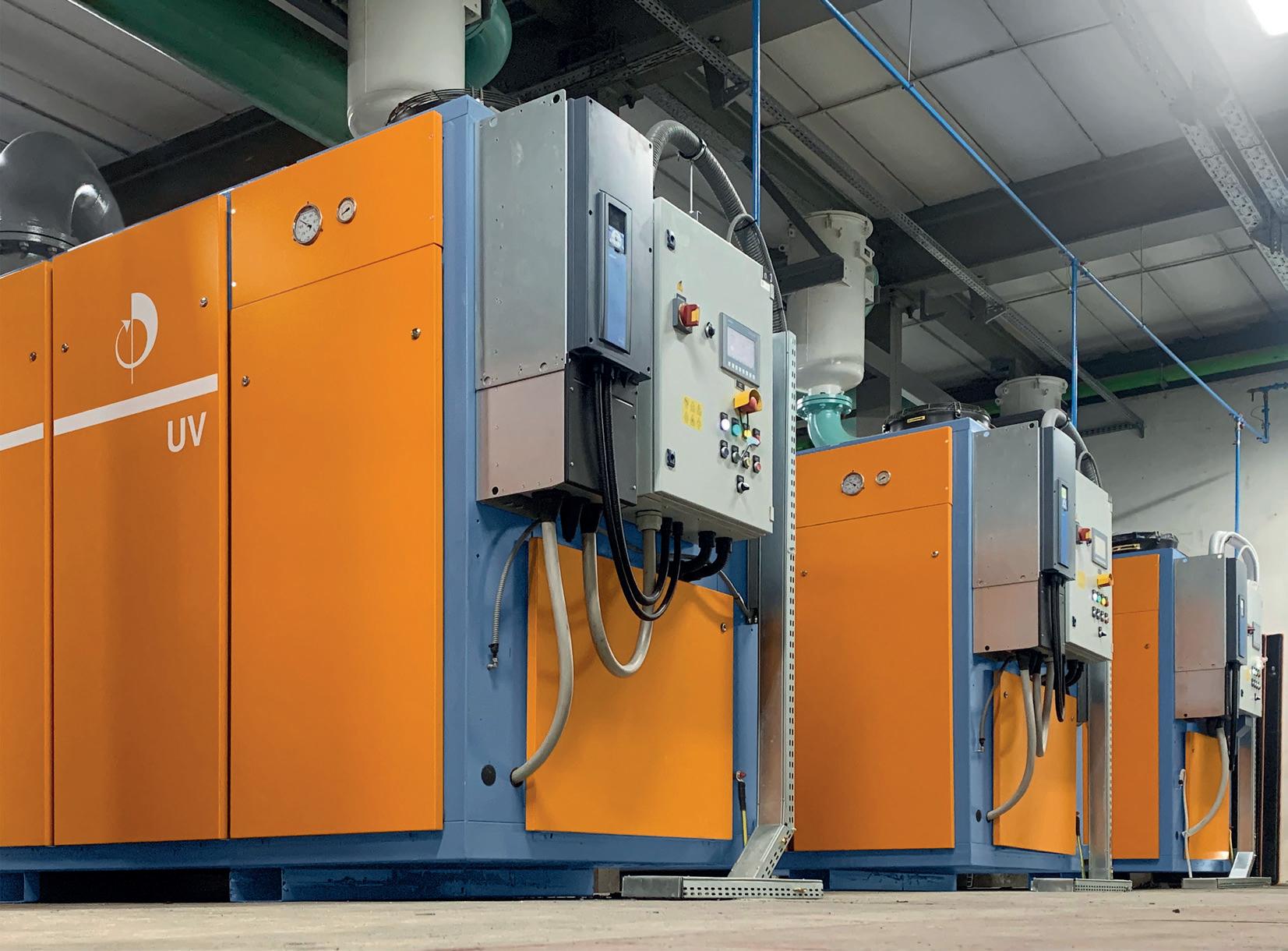
� Fig 2.Three UV50 VS90 W at Vetropack in Straza, Croatia.
slow-rotating, water-cooled rotary vane pumps of Pneumofore remained in place and continue to perform to this day - the only equipment from the historical past that was kept in service.
IT Solutions for Vacuum and Compression Control
The integration of status information from vacuum pumps into the digital factory, as recommended by recent industry 4.0 criteria, is becoming a standard. In addition, vacuum pumps and air compressors must also offer a communication interface to interact with a supervisory central control. Several factories have standards for electrical components, e.g. the entire process is based on Modbus TCP, ProfiBus with Simatic by Siemens or Ethernet IP with AB Rockwell IT components. For optimal functionality, it appears that also the brand of the electrical motor, its protection and efficiency degree, as well as valves, variable speed drives, or VSD, and soft-starts are specified. Consequently, off-the-shelf vacuum pumps and air compressors cannot be installed. Since the wish-list of engineers can sometimes exceed the budget, initial specifications become adapted or reduced to match what standard equipment is offered on the market at a lower price. If the budget is available, however, and the engineering specifications seek to match modern state-of-the-art criteria, it is recommended to use similar brand components for IT communication and LAN programming. Thus, a PLC and a VSD or another component are installed on-board of the vacuum pump or compressor in accordance with the latest technological standards. As a result, the electrical cabinet alone can double or triple in size and cost. Still, it is best not to ‘save now and spend later’, as the integration of industry 4.0 data transfer in a second step is possible but becomes more difficult and costly. Pneumofore’s flexible systems result in tailor-made machines which integrate industry 4.0 technology.
They can easily be set up with most popular components and protocols to achieve smooth communication. The supervisory control room of the glass factory has immediate access to all information, such as machine on/off, alarm, vacuum level, electrical data for kW, Ampere and Hz, hour meter countdown for service, and, in some systems, flow.
Air Compressors Revisited
Historically, industrial air compressors embraced electronic technology earlier than vacuum pumps. Variable speed drives and electronic controls appeared towards the end of the last century. Compressors called for energetic improvements decades ago, as the amount of electrical energy consumed for compressed air is far greater than for vacuum. Today’s challenge is to match the communication protocol used by customers in their SCADA. Serially produced machines usually fail to do so, therefore customised solutions are required.
Long gone is the era of installing an oversized turbocompressor and simply blowing off the excessive pneumatic energy or throttling the inlet to match the correct flow and pressure.
Environmental awareness now demands that industry contributes to reducing power consumption and minimizing pollution. The optimal setup in compressor and vacuum rooms consists of running several machines about the same size with a back-up.
These units are connected via an electronic box, a ‘machines management system’ that summarises all major information coming from the installed units. The most common protocols found in new plants are Modbus TCP, Profibus, Ethernet IP. For vacuum, Pneumofore has developed the VacMan, for up to eight connected pumps, which can be configured to run with all these protocols.
For the low-pressure compressed air used in moulding, it is today standard practice to avoid pressure reducers, as the compression to higher pressures requires more energy.
Best is the compression to the exact pressure required, e.g. 3.5 bar(g) and the option to vary the capacity by means of a variable speed drive, or VSD, in order to cover all production situations, including job changes. To manage several compressors, a popular device is the AirLeader, which takes data from each machine and transmits it to the Supervision Control System. This is the case of the A520.4 VS400 W air compressor running since 2019 at 3.5 bar(g) and serving the low-pressure pipeline loop at Ardagh Glass in Drebkau, Germany.
This compressor with a nominal 400 kW of power is water-cooled and is equipped with VSD to continuously adapt the machine’s rotation speed to the production requirements, maintaining the line pressure constant.
Not all units require a VSD. One frequency converter unit is usually
PSR SYSTEM 500 FOREHEARTH
Achieves the best glass thermal homogeneity and energy efficiency.
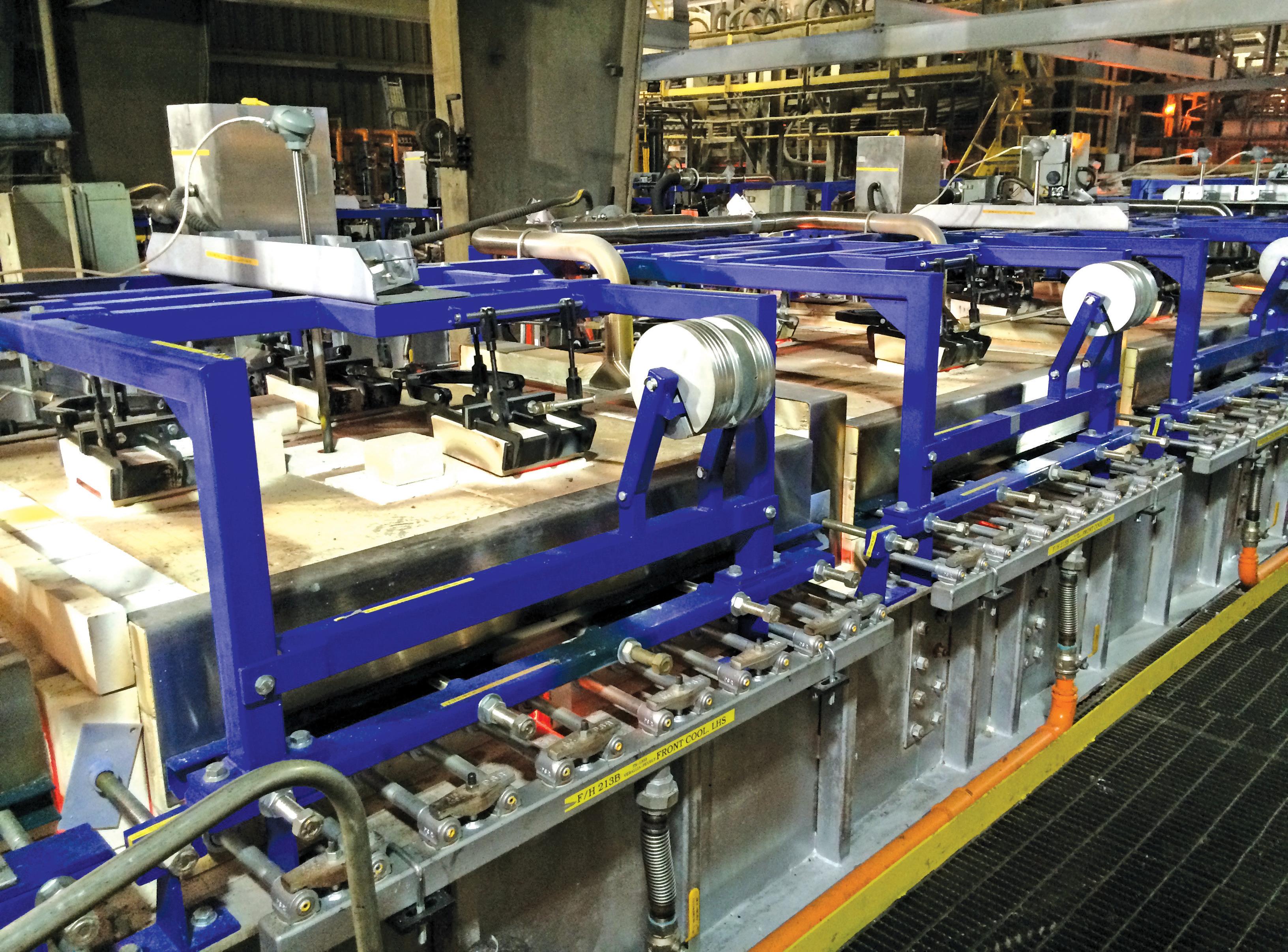
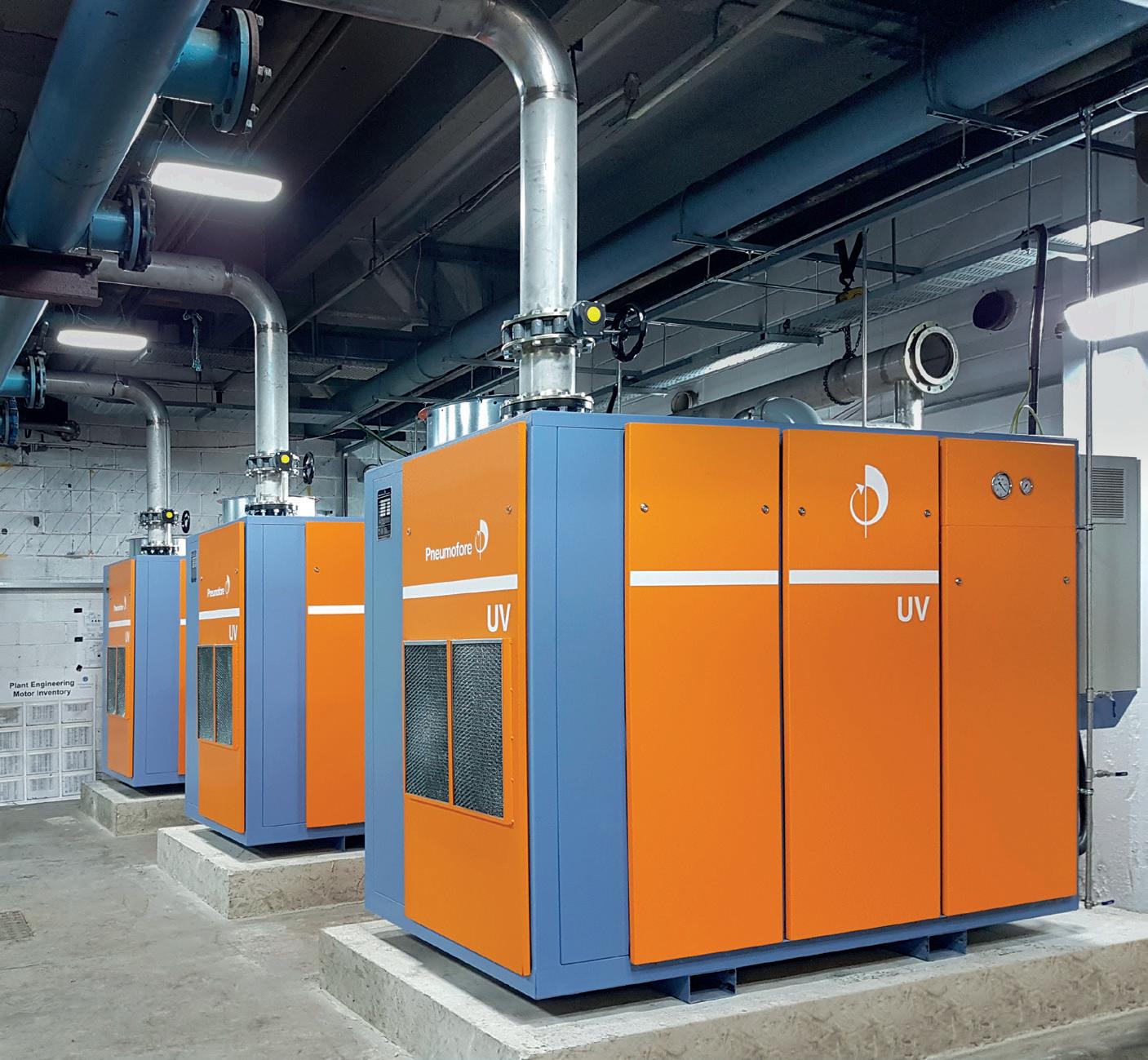
� Fig 3. Three UV50 W VS90 at Ardagh Glass in Doncaster, UK.
sufficient to cover the fluctuations of flow in m3/h by keeping the pressure constant. In locations with critical access conditions, the independence of the factory from the equipment suppliers is of particular importance, and therefore simpler solutions may be recommended. At Belstekloprom in Gomel, Belarus, next to one UV50 pump, four A260 compressors totaling more than 6.000 m3/h capacity were installed in 2008 and still run 24/7 today.
When compressing air, other important factors to consider are the air humidity as found near the sea and air density: compressors running at high altitude with ‘thin’ air will result in a reduced performance, unless appropriately sized.
Pneumofore machines supplied in “.alt” version (for Altitude) also feature a larger electrical motor, such as the units running at 2.650 m elevation at the O-I plant in Zipaquira, Colombia.
A Closer Look at Vacuum Control: Installation in Croatia
In some European countries, the modernisation of glass manufacturing plants has been supported by partial financing through national subsidies, particularly to meet the target of ‘green’ production as soon as possible - a rising interest in every industry.
What’s more, Industry 4.0 is understood as an update, as a new approach to modern productivity resulting in higher competitiveness with reduced costs.
This makes it the object of public funding in some nations. A fortunate situation was the installation of five Pneumofore pumps model UV50 VS90 W at Vetropack in Straza, Croatia, in 2021. The plant could profit from the reduced power consumption and the total integration in the SCADA, based on Siemens ProfiBus. Every pump has the HMI touch panel and each electrical cabinet contains one Siemens PLC S7 1200 processor for the high-level supervision of the machines, with considerable data transmission for the graphical display in the remote supervisory control room.
UK installation
The Ardagh Glass site in Doncaster, UK has three furnaces with 820 tons/day hollow glass production, split in two with East and West side, the total of about 100 sections on ten IS machines. Large plants such as this one benefit from the latest IT solutions in production: recently installed vacuum pumps that were successfully integrated in the SCADA system. Pneumofore supplied five units of UV50 vacuum pumps, customised according to the plant specifications in terms of communication protocols and components.
With AB Rockwell electronic components, including the Powerflex variable speed drive VSD and the Compactlogix PLC, the pictured three vacuum pumps are on the east side, whereas two units are installed west. Each vacuum pump room is equipped with the VacMan, which works as ‘sequencer’ for the even distribution of the working load; it represents the SCADA interface for remote monitoring. The five pumps were installed in 2020, the immediate result was a reduction of total power consumption, quantified as 24% by the customer at commissioning.
The access limitations to the site, following the pandemic, caused a delay in completing the installations with the VacMan controls and the connection to the SCADA. Nevertheless, during these months the customer could also benefit from the reduced service requirements, as the intervals for ordinary maintenance were extended to 8000 hours of operation. From an IT perspective, which required precise custom programming and testing, the installation is finally complete now that all five pumps are visible on the monitor in the control room, displaying the operation status, working hours, vacuum level, temperature, Hz of the VSD and hours left until maintenance.
Upgrading Aged Equipment
Ardagh has more Pneumofore vacuum pumps and air compressors within its constellation. Eight UV30 vacuum pumps have been installed since 1998 in Valdemorillo, Spain. They continue to run after 24 years of 24/7 operation, namely 200,000 hours with total customer satisfaction at the extreme reliability, high efficiency and low maintenance.
Typically, industry units of this age would be written off, yet in practical terms there is no reason to replace them. If required, these aged pumps could have the electronic board VIM installed, to connect them to the VacMan. However, over-digitalisation is a danger to the practical functionality of machines. The priority is to match the lifespan of the furnace with adequate means of control rather than deploying the latest control technology for its own sake. �
*President, Pneumofore, Rivoli, Italy www.pneumofore.com
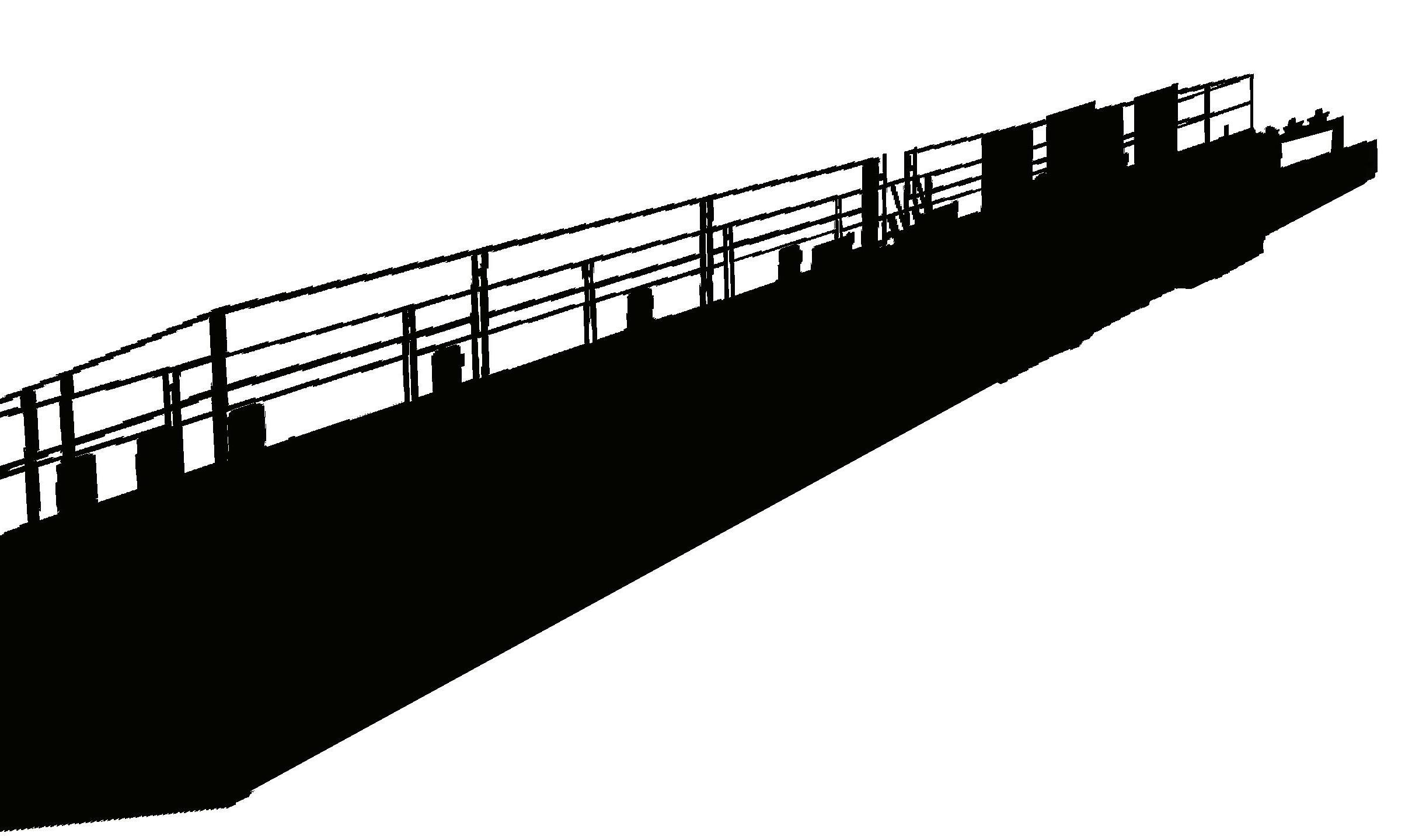
GLASS MACHINERY











